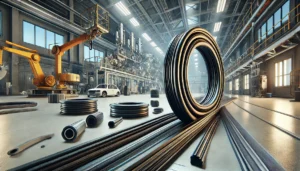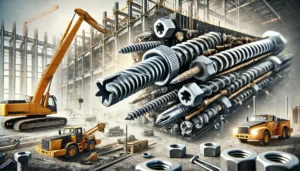Flanges are extremely important to piping systems because they link pipes and valves to other equipment such as pumps. Flanges serve the most fundamental role in the entire piping system. Sadly, flanges remain the single most problematic component to any system because they fail often. This failure often directly affects the efficiency of the entire system. It can do some serious catastrophic damages if not dealt with in a timely manner. In this post, we will identify issues pertaining to flange failures and also address how one can fix those issues without rupturing the entire system.
1. Improper Installation Practices
One of the most common causes of flange failures is improper installation. When flanges are not installed correctly, it can lead to misalignment, uneven pressure distribution, and ultimately, leaks. Several installation errors can result in flange failure:
- Uneven Bolt Tightening: If the bolts are not tightened evenly, it can cause uneven compression on the gasket, leading to leaks. Uneven tightening also puts excessive stress on certain parts of the flange, which can weaken the connection.
- Misalignment: Gasket leaks are caused due to the uneven compression from misaligned flanges not being paralleled. The flange could also collapse if the fluid or gas’s internal pressure is too high and the bolt holes are out of alignment.
- Incorrect Gasket Installation: A gasket crafted from the incorrect flange material poses the risk of reducing structural integrity leading to its failure. Gaskets should account for the conditions: temperature, pressure, and gasket type that needs to be used along with the area where the bolt holes are located. An inappropriate environment can cause a bad seal that results in leaking.
Preventive Measures:
- Ensure proper training for installation personnel to follow correct procedures.
- Use torque wrenches to tighten bolts evenly in a crosswise pattern.
- Ensure the flange faces are aligned and use alignment tools if necessary.
- Use the correct gasket material and ensure proper installation.
2. Material Selection Issues:
Bolts need to be pulled tight using a torque wrench in alternating directions. Flange faces need to be parallel and proper alignment tools should be used when needed. Gaskets need to be installed properly and correct materials must be used. A major contributing factor to gasket leakage is applying the wrong materials on different environments as it exposes the bolt holes to corrosion along with weakening the structure and eventual failure.
- Corrosion Resistance: While carbon steel possesses great strength, it may not be very effective against corrosive environments. For applications involving the movement of aggressive fluids or gases, or environments where humidity and chemicals are abundant, stainless steel or other special alloys tend to work best.
- Strength and Durability: Flanges which endure high levels of pressure or temperature rely on materials that can withstand the extremes. Employing weak materials with low thermal stability could result in deformation, cracking, or total failure.
Preventive Measures:
- Choose materials that will endure the pressure, temperature, and the fluids or gasses used.
- Continually assess the material requirements depending on the operational changes or new advancements in material technology.
3. Corrosion
Corrosion Flange discord is caused by corrosion in both domestic and industrial environments. Flanges left unattended and exposed to extreme, and destructive weather conditions will greatly weaken the flange over time, and if worse, potentially cause leaks or cracks. Systems containing chemicals, water, or even salt would suffer from rapid onset corrosion, making the flanges ineffective engagements.
Preventive Measures:
- Steer clear of using materials that rust, like spending alloys or stainless steel in highly corrosive settings.
- Corrosion can also be minimized by applying shielding paints to the flanges.
- Look for signs of rust and attend to them promptly by maintaining regular checkups.
4. Thermal Expansion and Contraction
Thermal expansion and contraction of materials places excessive strain on flanges as is the case for most systems where changes in temperature are routine. Change in the temperature of materials results in expansion or contraction which exerts loads on the connection flange. This extreme case of excessive force can lead to misalignment, gasket failure, or in worse conditions flange rupture.
Preventive Measures:
- Include expansion joints or flexible piping sections to adapt to temperature changes.
- Employ materials that can sustain the temperatures within the system.
- Gradually change the temperature at which fluctuation is experienced in the system.
5. Mechanical Vibration
Vibration deranges the alignment of flanges loosening bolts while simultaneously putting the flange components at risk of failure. Pumps, motors, and compressors start the vibrations that overtime worsen the condition of flange connections. Damage caused by vibration undoes approach relies on gaskets as well which brings about leaks.
Preventive Measures:
- To lessen the impact of mechanical vibrations use vibration dampers or isolation pads.
- Flange components which include bolts and gaskets, must be able to function under the vibration forces induced.
- Regular maintenance is crucial to items that produce mechanical vibrations in order to damp the detrimental effects on the flange joints.
6. Overloading
Overloading refers to the situation where the connection formed by the flange is subjected to excessive pressure or mechanical loads than what they have been designed for. As a result, the flange may deform, along with some gaskets and in dire cases, ruptures. This issue can arise due to failing to properly design the system, using substandard materials, or by using unaccounted for pressure surges, and effervescing shock loads.
Preventive Measures:
- When designing the piping system, make sure to base the selection of flanges on the maximum operating load they will experience.
- In order to relieve potential over straining of flicked joints, install pressure relief valves.
- Conduct regularly scheduled maintenance for the devices that released excess pressure.
7. Inadequate Maintenance
Loosening the regulations on routine maintenance can result in untraceable anomalies, which will in turn lead to system collapses. Inspections of the flange connections must be done regularly as they may suffer from wear and tear, corrosion, and even damages. Not imposing these checks can result in small complications that grow exponentially and result in expensive repairs and system offline time.
Preventive Measures:
- Create a regular maintenance routine in which visual inspection, connection torquing, and examining the condition of the gasket are done.
- Employ methods like ultrasonic testing and dye penetrant testing to expose hidden flaws in parts.
- Before components, such as gaskets and bolts, begin to fail, they should be replaced with one that is slightly more advanced.
Conclusion
Flanges used in piping systems are subject to severe stresses which leads to buckling and breaking. These expenses can be highly damaging to the business due to productivity loss, increase in safety ramifications, and maintenance spending. Understanding flange failure causes paired with preventive practices can help make businesses more cost-effective. Selected and properly installed materials, precise maintenance of flange connections, and modern technologies such as vibration isolation and corrosion resistant materials add to the reliability, safety, and efficacy of piping systems. These systems should also meet the set industry standards in order to ensure flange connections are not easily compromised, mitigating downtime caused by flanges.










